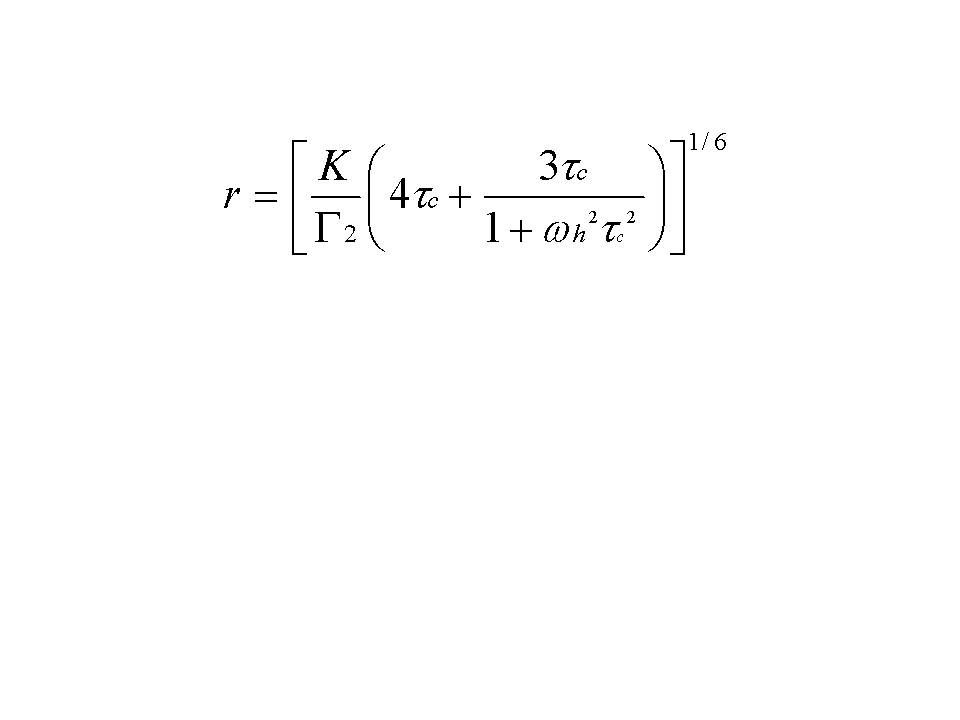Paramagnetic relaxation enhancement
From NMR Wiki
Paramagnetic Relaxation Enhancement may be first attributed to the work of Solomon and Bloembergen in their work with NMR in the 1950s [1] .(Solomon also describes equations derived from Overhauser for the nuclear Overhauser effect).
Paramagnetic Relaxation Enhancement (PRE) is increasingly becoming a method to provide long-range distance information that can complement NOE restraints, which are limited to distances of less than 6A. This method can be used to get distances in the range of 15-24 A (for a lone spin of a nitroxide stable radical). Distances between the spin label and NMR active nuclei can be determined from the increased R2 relaxation rates. The equation that describes the increased relaxation rate is termed the Solomon-Bloembergen equation. Below is a modified version of the equation used in biomolecular NMR (Wagner et al) [2]:  .
.
Spin labels placed on macromolecules can be also used to screen for binding small molecules [3] as PRE will be transferred onto small molecules that bind macromolecules at intermediate exchange regime (see Chemical exchange; see also STD method). A means by which one evaluates the structure generated by PREs is the Q-score(for a comprehensive review of paramagnetic relaxation enhancement for macromolecules see Clore, G. M., and Iwahara, J. (2009) [4].
In addition, PRE has been used for an accelerated data acquisition due to increased longitudinal relaxation rates. This is particularly useful for systems with naturally long T1, including biomolecules [5] and human tissue (in medical applications).
Encounter Complex
Much research has been devoted to research about transient states of biomolecular complexes. For a conceptional review of the idea of an encounter complex please see [6]
References
- ,Solomon, I. (1955) Relaxation Processes in a System of Two Spins, Physical Review 99, 559 [1]
-
Battiste, JL and Wagner, G. Utilization of site-directed spin labeling and high-resolution heteronuclear nuclear magnetic resonance for global fold determination of large proteins with limited nuclear overhauser effect data. Biochemistry 39(18):5355--65, 2000. BibTeX
-
Jahnke, W. Spin Labels as a Tool to Identify and Characterize Protein-Ligand Interactions by NMR Spectroscopy. ChemBioChem 3(2-3):167--173, 2002. BibTeX
- , Clore, G. M., and Iwahara, J. (2009) Theory, practice, and applications of paramagnetic relaxation enhancement for the characterization of transient low-population states of biological macromolecules and their complexes, Chem Rev 109, 4108-4139 [1]
-
Linser, R, Chevelkov, V, Diehl, A and Reif, B. Sensitivity enhancement using paramagnetic relaxation in MAS solid-state NMR of perdeuterated proteins. Journal of Magnetic Resonance 189(2):209--216, 2007. BibTeX
- ,Ubbink, M. (2009) The courtship of proteins: understanding the encounter complex, FEBS Lett 583, 1060-1066[1]
-
Liang, B and Bushweller, JH and Tamm, LK. Site-directed parallel spin-labeling and paramagnetic relaxation enhancement in structure determination of membrane proteins by solution NMR spectroscopy. J Am Chem Soc 128(13):4389--4397, 2006. BibTeX
-
Gillespie, JR and Shortle, D. Characterization of long-range structure in the denatured state of staphylococcal nuclease. II. distance restraints from paramagnetic relaxation and calculation of an ensemble of structures. Journal of Molecular Biology 268(1):170--184, 1997. BibTeX

